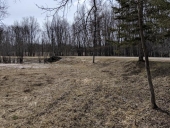I have been reading the excellent book "The Hidden Life of Trees" by Peter Wohlleben. On page 87 he talks about how during a rain event if the soil becomes saturated, excess
water runs off, taking tiny particles of soil with it. In this way large amounts of soil can be lost. Apparently as much as 2,900 tons per square mile per year, according to this book. If the soil is thin, he seems to indicate, then it will reach it's saturation point quickly, and erosion will happen with greater frequency and quantity in comparison to thicker soils.
I have a forest with gentle to moderate slopes with less than an inch of topsoil. If Wohlleben is right, it doesn't take much rain for this soil to reach it's saturation/erosion point. There are also huge piles of fieldstone all over this forest. (I imagine the stone piles give a clue as to why the soil is so thin, this area must have been farmland before it grew back up into forest).
So here is my idea, which is not really my idea at all because I have read about similar things elsewhere. Take the fieldstone, which is already onsite and accessible, and make heaps on contour, about a foot high and a foot wide. Wherever the heap meets a tree it can stop and then start again on the other side. After leaf fall the spaces between the stones will be filled with leaves. Then when water runs off, the linear heaps will hopefully slow it down and catch most of the soil particles that are in it, as well as small bits of other types organic matter. I would like to think that this system would build topsoil by at least an order of magnitude faster than simply doing nothing. (I do acknowledge that sometimes doing nothing is the best option).
If everything works as well as I hope, then I can use Stone Age technology to build a machine that will build soil depth for centuries to come. I don't yet know how far apart on slope one heap
should be from the one above or below it, and I don't know if one foot is the optimal height and width.
Pros: no digging, all materials are already onsite, very little disturbance, should last for a very long time, might save literally tons of soil from washing into the creek. Can anyone think of some more?
Cons: stones are heavy, I don't know if this will really work. Can anyone think of some more?
I am interested in all suggestions, critiques, ideas, etc.

 1
1













 1
1









 1
1

































